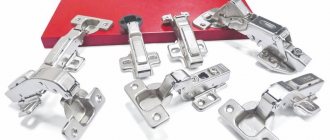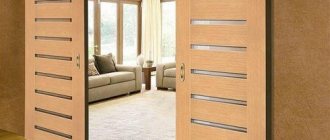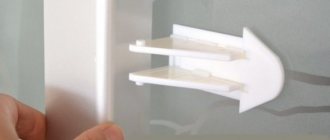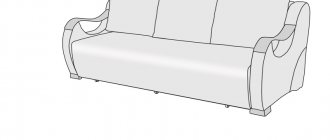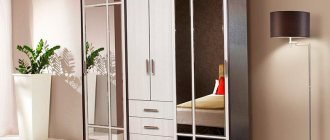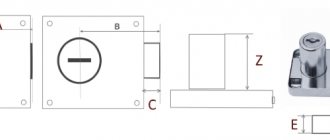The upper part of tall, massive cabinets is usually reserved for rarely used and unnecessary things. Old outfits that are inappropriate for the current season are sent there. This is because to access it you need to stand on a chair, stool or use a ladder. But there is a device that can provide free access to the top of the wardrobe and convenience when choosing clothes. Let's look at a pantograph for a closet, what it comes in, how to make and install a furniture lift with your own hands.
Purpose, design, operating principle
A pantograph is a U-shaped lever telescopic mechanism that lowers the top rod with clothes to the level of the first floor of the closet.
The lifting mechanism, consisting of two parts and equipped with a casing, is attached to the walls of the cabinet. Two side levers extend upward from it, carrying a sliding rod, to which a handle is attached in mechanical models.
As a rule, the pantograph is equipped with a rod as a support, but sometimes a cable plays this role. The retractable rod, on which hangers with clothes are hung, adjusts to the width of the closet section.
Expert opinion
Bashir Rabadanov
Technologist at the furniture company Woodband
Note: the word pantograph has several meanings. Firstly, it is a drawing tool that allows you to measure equal segments and copy data in drawings, symmetrically about the axis or offset. Also called a pantograph in electrical engineering is a current collector or pantograph that provides vertical movement of a contact runner and connects an electric train or tram to a line (wire).
The "clothes lift" can keep expensive dresses away from pets who like to explore their surroundings and away from children who might get their clothes dirty. It is also a good solution for older people and people with disabilities.
What is it and how does it work
The pantograph is presented in the form of a U-shaped structure. It is often made from high-strength metal.
Pantographs are used for wardrobes and dressing rooms as an element of internal filling.
See also
MDF kitchen facades: what types are there, price, customer reviews
The main task is to improve the performance characteristics of furniture, increase its practicality, and achieve maximum capacity. An excellent solution for those who have purchased a tall wardrobe, but at the same time cannot, due to their height or the furniture being really too tall, make full use of the space above. The pantograph makes it easy to place clothes at the top and lower them down as needed with simple movements.
Manufacturers of furniture fittings, such as GTV and the equally well-known Hafele brand, use high-strength types of metal in the manufacture of such elements.
The pantograph places increased demands on structural strength, since it is designed to withstand impressive loads during operation. You can even place winter outer clothing on it without any problems, without fear that the crossbar will break.
Moreover, for outerwear it is preferable to choose models with wall mounting, thereby guaranteeing full resistance to loads.
Structurally, the hardware under consideration consists of several elements:
[adv1]
- sliding bar;
- control knobs;
- side arms;
- boxes with slots for fixation;
- elements for fastening to a cabinet or wall;
- decorative overlays;
- protective coating on metal;
- drive;
- additional components.
The device works quite simply. But a lot depends on the drive circuit. A special handle allows you to lower the bar down. By applying a small reverse force, the element will return to its original position.
Types of pantographs
Furniture elevators are made from metal, plastic and composite materials. The latter are lighter, have the same strength and rigidity, do not rust, but are much more expensive.
Classic furniture elevators
The types of pantographs are:
- mechanical. They operate on the principle of a multi-stage switch. There are two positions where the levers stop, but some models have intermediate positions. In order to return the hanger to its place, you simply need to move the rod to a different position;
- automatic. To lower, you need to press the button and wait until the hanger lowers;
- manual. They can be equipped with a return spring or rubber bands that will return the hanger to the top if you release the handle or cable.
Among the filling of the dressing room, pantographs stand out especially
Regardless of the type, the principle of operation is the same for all: you pull the handle towards you, and the bar with the clothes lowers; a slight push from yourself will cause the mechanism to return to its previous position.
Types of pantographs and their characteristics
All pantographs protect things from being crushed and keep things in neat condition.
Mechanical
Mechanical ones operate on the principle of a multi-stage switch. The levers stop in two positions; some models provide intermediate positions. To return the hanger to its place, the rod must be moved to a different position.
When choosing a furniture elevator, focus on the load capacity.
Electrical
Control is carried out using a special button. Electropantographs are not much different from mechanical ones. It all depends on the specific model. The load capacity of such models does not exceed 20 kg. It is recommended to install the electropantograph in a children's room. The device will also be useful for older people. The average cost of such a model is 7 thousand rubles, which is not cheap.
A great option for children, the elderly, and people with disabilities.
How to choose a clothes lift
To ensure that your purchase expectations are justified, follow these simple rules:
- The dimensions must match the dimensions of the cabinet. Typically, the extension range of the rod is from 450 to 1250 mm.
- The carrying capacity of the model must be selected according to the amount of clothing. The wider the section, the more hangers will fit.
- If there is high humidity, buy a plastic model; metal is susceptible to corrosion.
- Spread and opening angle. Measure the space in front of the cabinet doors, will it be possible to fit the extended pantograph, will there be anything in the way?
- Reviews of manufacturers and their reputation will help you make your choice.
- The price of a pantograph depends not only on the company, but also on the type of mechanism: spring, gas and electric.
- Don't forget about the warranty period, especially when buying expensive devices.
The clothing lift is convenient in large dressing rooms and ordinary wardrobes.
Below is a table of the best mechanical models, with the specified characteristics and average price in Russia.
| Mechanical models | ||||
| Manufacturer, name | SERVETTO ONLY | AMBOS 700 | ONLY 730 | STARAX S-6013 |
| Lifting mechanism | hydraulic | |||
| Section width (millimeters) | 600-1200 | 750-1150 | 730 — 1190 | 600-900 |
| Rod type | telescopic | sliding | ||
| Load capacity (kg) | 12 | 15 | 14 | 12 |
| Material | steel, plastic | chrome steel, plastic | steel, plastic | metal, plastic |
| Color | grey, brown | white | white | grey |
| Average price (rubles) | 9100 | 6200 | 8663 | 3650 |
How to choose
When choosing a pantograph for a wardrobe, it is important to be guided by the following criteria:
- price and management principle. Mechanical models are slightly cheaper than electric ones. And excessively cheap products should scare away the buyer in both cases. Most likely, a cheap product will very quickly lose functionality;
- quality - the selected product must certainly be made of high-quality materials, otherwise it will last a short time. Ask the seller if there is a quality certificate. Products without such a document included are not worth the attention of buyers;
- dimensions - carefully measure your wardrobe using a construction tape. This will allow you to determine the current dimensions of the pantograph.
If you have minimal experience in such matters, you can seek help from an experienced specialist. He can also install the product.
How to install a pantograph
Let's consider the most difficult option - installing a pantograph, which runs on mains power and is driven by a button. The procedure is as follows:
- Unpack the pantograph and conduct an external inspection before connecting. It is advisable to enable it to test its functionality before installation.
- Measure the distance to the outlet to make sure it is sufficient. Otherwise, you need to move the socket or extend the wire.
- Remove all items from your wardrobe and try on the lifting mechanism.
- Make notes for the fasteners according to the instructions in the box. If there is no documentation, measure all points manually. They should be at such a height that long dresses and jackets do not touch the bottom of the closet, but hang freely in the air.
- Drill holes at the fastening points.
- Secure the lifting mechanisms. Don't mix up the sides!
- Install a metal frame with a lever into the grooves.
Ready. Now you can use a button or pedal to lower and raise the hanger in a couple of seconds. Mechanical options are installed in a similar way, except that they do not need to be connected to the network.
Expert opinion
Bashir Rabadanov
Technologist at the furniture company Woodband
Most pantographs have a rod clearly in the middle to evenly distribute the center of gravity. This structural element divides the entire hanger into two equal parts, eliminating the possibility of free movement of things between them. The partition in the center is not always convenient, and if it is on the side, the opposite edge may sag under the weight of clothing. Intricate designs with two stands on the sides save the situation, but most of them have a “pillar” in the center.
Article about furniture
Author - designer of the company DEZALT Sukhanov Eduard
When is a pantograph needed?
In short, and without wasting your time, the pantograph should be installed as a last resort, when you have a lot of outerwear and you need to hang it in the second row above the bar. Only in this case install a pantograph.
Now in more detail.
The minimum distance for short clothing from the floor to the bar is 90 cm, this is the minimum. This size fits a men's shirt, trousers folded in half, a jacket, but nothing more. If your jacket is knee length, it won't fit anymore.
The normal size for short outerwear is 120cm, but if you like something just below the knees, it’s better to make the distance under the barbell 140cm, you can’t go wrong.
If you like long raincoats, fur coats, dresses, then you need to leave a distance of at least 150cm, and preferably 170cm. We once had a client who was about 180cm tall and she was a ballroom dancer. We made the distance to the bar more than 2 meters so that the dresses would not lie on the floor.
You can go and measure your clothes hanging on hangers, from the bar to the bottom. Give a margin of 10cm. and you can safely put the resulting height in the new cabinet.
And now we are approaching the pantograph. There are cases when there is not enough space, but there are a lot of clothes on hangers, you need to put them somewhere. The first rod is set at 150cm. from the floor, about 120-130cm remains on top. (of course this depends on the height of the room). In this case, you can install a pantograph on top of the bar. It is more suitable for storing things up to 120cm. in length, because if you hang long clothes, when lowering and lifting them, they swing strongly and sometimes even the hem of the clothes lies on the floor in the lowered state.
Example
To lower the pantograph, you need to grab the central handle and pull it towards you. You will feel resistance, especially when the pantograph is empty and still brand new. When he is under the weight of clothes, it will be easier to lower himself.
Different manufacturers indicate approximately the same load on the pantograph, from 10 kg. up to 14. The width of the pantograph can be different, there are several standards for different sections: From 500 to 750mm, from 530 to 680mm, from 690 to 990mm, from 860 to 1150mm, from 750 to 1250mm. As you understand, you can choose a pantograph for a section from 500 to 1250mm.
The price of pantographs also varies greatly, depending on the manufacturer, from 2000 rubles. up to 14,000 rub. The most expensive ones I've met are Italian. Perhaps there are other manufacturers that I have not even heard of, perhaps with higher prices, but I will rely on my experience.
The most common version of the pantograph is symmetrical, when it looks like the letter P. It is usually attached to the sides of the cabinet on the left and right, with a hanging handle in the center. A lesser-known design is the asymmetrical pantograph, it resembles a beech G and also has a handle for lowering. Our company has never installed such a pantograph; I can’t say anything about this design.
The pantograph lifts clothes using a gas or oil mechanism. Here I do not undertake to say which one is better and which one will last longer. From practice, I know that Chinese pantographs, which cost around 2-4 thousand, fail after 3-5 years of operation. Alas, this happens. There are of course exceptions when it works for 7-10 years. Italian ones are still of better quality in this regard; they last for 7 years or more. We have not yet learned the limits of their work, since no one has yet complained about Italian mechanisms. Perhaps people simply do not contact us and solve the problem on their own. And to be honest, we installed them infrequently, over the entire period (since 2009) maybe 5 times, because the price is very high compared to Chinese ones, 3 thousand versus 8.
Turkish pantographs are somewhere between China and Italy in quality, but there are also surprises. Once we were installing a Turkish pantograph and when the mechanism was lowered, the plastic rubbed against the tube with a characteristic sound. We studied everything carefully, the reason was in the body of the right mechanism, the clearance for the tube stroke was less than that of the left. The geometry of the cabinet body or the installation method were done correctly, we double-checked everything, it was just a manufacturing defect. In order not to waste time replacing the pantograph, so as not to get on our nerves with the supplier, to prove that we are not to blame, we carefully disassembled the right mechanism and ground off the plastic at the attachment points by a few millimeters. This solved the problem.
When the pantograph is empty, when lifting it up, you need to hold the handle with your hand, otherwise it will crash into the wall by inertia. When the clothes are hanging, firstly, the pantograph will not rise so sharply, and secondly, the handle should slow down on the hanging clothes.
Most often, pantographs are mounted on the sides of the cabinet, directly on the chipboard. Be very careful and attentive with the length of the screws included, sometimes they are longer than required. For example, we use 16mm thick laminated chipboard. and sometimes the self-tapping screws that come with the kit can be several millimeters longer, apparently designed for panels 18mm thick. You can go right through with self-tapping screws.
There are pantographs with wall mounting, we installed this once. I think they are designed more for dressing rooms, because sometimes laminated chipboard stands are unnecessary in dressing rooms and it turns out that there is nothing to attach the pantograph to. Perhaps that’s why they came up with wall-mounted ones. Wall pantographs are rare and their selection is small. We bought an Italian one from Ambos for 12,000 rubles. approximately, I repeat, they simply did not find an alternative.
How do expensive pantographs differ from cheap, less famous ones? As I said, firstly, by service life, and secondly by quality, which is understandable only in comparison. Another plastic, it does not have an unpleasant odor. All edges of all parts are without sharp burrs, there are no unnecessary roughnesses. The connecting elements are similar to Chinese samples, but it feels like they are made well.
The only thing that was surprising to me was that the U-shaped structure of the elevator did not have any additional strength when lowering and raising it. In the same way, the tubes play left and right and sway slightly. I still expected that the mechanism would lower evenly, even more smoothly, without the slightest distortion. Nothing like this. The work is no different from its Chinese counterparts. The brakes are a little softer in the lower and upper positions, but there are no more differences.
Is it possible to do without a pantograph? Yes, it is possible and many get by. If you are willing to stand on a small stool or stepladder to remove or hang clothes from the ceiling, then you do not need a pantograph. Upstairs you can hang clothes that are currently unnecessary. There is also a telescopic hanger stick that can be used to hook the hanger and hang clothes on the bar.
All pantograph designs are narrowed, this is done so that when lowering the tubes they do not touch swing or compartment doors. It turns out that you lose about 10cm. useful length of the rod. In general, all retractable furniture fittings, such as mesh baskets, trouser holders, tie holders, shoe racks, are all a waste of space inside the closet. Such things can be justified in the dressing room when there is free access to them, you do not have an urgent need to save every centimeter. But in the closet, the extension mechanisms eat up the volume. There are restrictions on the depth and length of retractable fittings. You can lose space not only from the sliding mechanisms, but also from the shallower depth. For example, your closet is 60cm inside, but your basket is only 50cm. That means 10cm. goes nowhere. If you make a drawer or shelf from chipboard, there will be more benefits.
I told you all the features about pantographs, my personal conclusion is this - if you really need a second row of clothes for every day, install a pantograph, preferably a branded one.
Well, if you can do without it, it’s better to refuse. All articles
Operation and repair
As a rule, pantographs work properly for the first six months. After this period, the following problems are possible:
- creaking or crackling. Treated by lubricating the angle mechanism;
- difficult or asynchronous opening. If you pull the frame from one side, there will be a skew with a displacement of the running axle. Regular lubrication will not help; you need to straighten and level the entire frame;
- with mechanical options, the hanger stops returning to the top position or does so slowly. Most likely the spring has stretched, which now prevents the frame from moving upward.
- the top bar is not fully in position. The cause may be a spring or a broken angle mechanism. Also, a foreign object can become an obstacle on the way up;
- In automatic pantographs, the mechanism may jam, as a result of which the lowering occurs jerkily or the bar randomly rises up.
Regardless of the design, problems most often lie in the drive mechanism. The frames and slats are quite strong and do not pose a high risk of breakage.
If the structure does not lower or is tight, it is better to check the mechanism rather than pull by force, as you can knock over the cabinet or simply tear out the fasteners and damage the furniture.
Advantages and disadvantages
In most cases, a pantograph helps improve the quality of life. But it also has disadvantages.
Advantages:
- makes it easier to find, get and hang things in the closet;
- improves ventilation: clothes are fresher;
- makes it easier for older people and people with disabilities to get things;
- frees up the lower part of the cabinet for additional shelves;
- reduces the need for ironing: you can hang more clothes than in a regular closet.
The main disadvantage is wear and tear over time. Gradually, backlashes form between the structural parts, which disables the entire mechanism.
It is almost impossible to repair individual parts of the pantograph; the entire system has to be replaced.
This design is inferior to a conventional horizontal hanger bar, which can last forever
Another drawback is the possible creaking of parts during operation. This becomes a problem if the closet is located in a shared bedroom. Compared to a regular bar, pantographs are significantly more expensive and require more complex installation.
conclusions
Now you know everything about furniture pantographs and can choose and install this mechanism in your closet yourself. Let's summarize the article:
- pantograph simplifies access to the upper sections of the cabinet;
- There are mechanical and electrical models;
- You can install the device yourself;
- Convenience and ergonomics are compensated by the high price.
An ingenious engineering design solved the problem of operating tall wardrobes without mezzanines. It is very easy to get any item from your wardrobe if you have a pantograph. Take advantage of modern solutions.
Possible repair and replacement of the pantograph in the wardrobe
Separate components for pantographs are not available for sale. That is, independent repair and replacement of failed parts is impossible; a complete replacement of the mechanism with a new one will be required.
Possible problems during operation of the pantograph and how you can repair it yourself:
- Unpleasant squeaking noise when moving . Try removing the plastic casing and lubricating the moving parts of the mechanism. Perhaps this is the reason.
- The racks are skewed and movement is difficult . When using a pantograph, you should try to place clothing evenly by weight along the entire length of the rod. Otherwise, due to different loads on the side posts, the pantograph will warp when lowered.
- Slow return of the elevator to the vertical position, you have to “push”. Perhaps this is due to a very large load exceeding the recommended one. Also, the mechanism quickly fails if it is secured high and is periodically lowered with force below the possible level. To avoid this, you can install corners or shelf holders on which the pantograph verticals will rest in the lowest position.
Like any lifting mechanism, a pantograph for clothes in a wardrobe requires careful operation and timely adjustment. If you follow all the recommendations in the instructions supplied with the device, the furniture elevator will function trouble-free for at least 3-5 years.


